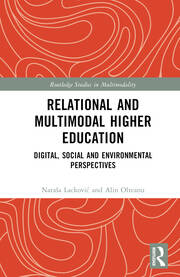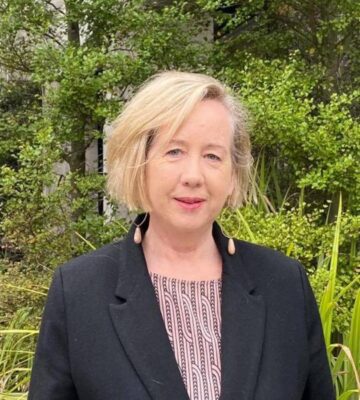Lacković, N., & Olteanu, A. (2023). Relational and multimodal higher education: Digital, social and environmental perspectives. Routledge. https://doi.org/10.4324/9781003155201
This book responds to some of the most pressing issues of our times in and for education. Although it is targeted towards higher education, the understated reach of this volume has implications for all ages and spheres of learning. Important messages concerning the relationality of all things in our contemporary world are artfully wrapped up in a relational membrane that invites age-old principles concerning ethics, self-other and social justice into the midst of rapid digital advancements and new forms of ‘otherness’ now entering the educational milieu.
Tackling the complex and shifting sands of relationality full-on, the authors advance three interconnected dimensions concerning i) human society; ii) environment and the more-than-human; and iii) digitalisation. Each is eloquently woven together throughout the book in a series of multimodal representations of learning. Together, they cohesively and persuasively build pedagogical knowledge through creative engagement with ‘other’ across these domains. The co-constituted nature of these encounters brings new epistemological questions into view concerning how we come to know and, importantly, how learners might be agentic about representations that concern and shape their learning (and indeed, lives).
The authors systematically locate their inquiries in what might be described as a post-Piercean semiotic turn to layered meaning-making and interpretation ‘with,’ not ‘for’ learners. Presenting a variety of thought experiments through case study dialogues with academic professionals in the field, the sign is thus brought into dialogue with its ontological premise and purpose(s). On more than one occasion, I was reminded of the prequel influence of Inna Semetsky and Andrew Stables ‘edusemiotics’ in making this turn. However, Lackovic and Olteanu take us several steps further along this path by advancing a kind of ‘semiotic intersectionality’ with the multimodal. The corresponding acknowledgement of the role of modalities in curating multiple, often competing, identities opens up possibilities to see learners beyond traditional constructions of what learning matters, or for whom.
A significant contribution of this book thus rests in the treatment of connected identities that are visibilised when diverse digital, more-than-human, and multimodal representations and connections are granted legitimacy in educational spaces. Their manifestations, particularly by learners themselves, pose important questions concerning future becomings – their formation, generation and curation. An identity+ is forged out of these creative constellations. Many illustrations are provided to augment this premise, alongside practical discussions and dialogues concerning their significance for learners. In this respect, we see the authors living out their claims on every page of the book through dialogically conveyed illustrations, images, photos, as well as text. Here, multi-modalities are not merely spoken of but lived with in all their constructions and conceptions.
This is indeed a book for our times. The authors do not shy away from important issues facing teachers and learners today, such as ‘cancel culture’ and ‘selfie-dom.’ Rather, a relational antidote is called for through critical awareness. Bringing the rhetorical nature of modalities can de-crown any master discourse at play as a consequence. It was unsurprising, having recently had the privilege of attending Banksy’s art exhibition this year. Therefore, to discover a tongue-in-cheek photo of Natasa Lackovic beside a Banksy mural early in the book. The relational nature of co-creation and modal manipulation to convey important messages beyond words and beyond any singular image is keenly felt in such renderings. In the wake of fast-changing AI worlds now upon us, relational antidotes of this nature are desirable and downright necessary if we are to navigate these waters agentically.
While careful attention is paid to multimodal interanimations with digital and postdigital learners throughout this book, much is left unsaid concerning more-than-human, place and culture intersectionalities. Such additional layerings may be fruitfully explored in the parallel field of relational pedagogies, which, by its very nature, seeks out the dark matter of learning that cannot be otherwise contemplated through traditional (and perhaps even contemporary) dominant modes of inquiry. So, too, in (inter)cultural sites of learning, it becomes increasingly imperative to interpret learning through Indigenous modalities in thought and practice, and through the semiotic modes of construction that align with alternative epistemologies and ontologies. While many of these may seem less obvious in mainstream higher education institutions, they are nonetheless omnipresent in the dynamic learning spaces presented throughout this book. Where they seem absent, it is the task of education to wonder why. I invite such ponderings concerning identity+ in this regard, and to future advancements on this ground-breaking text through further interanimations with ‘others.’ In this regard, this book sets in motion a new era of scholarship in what we might now call a rhizomatic and multimodal semiotic and educational field of inquiry and practice.




